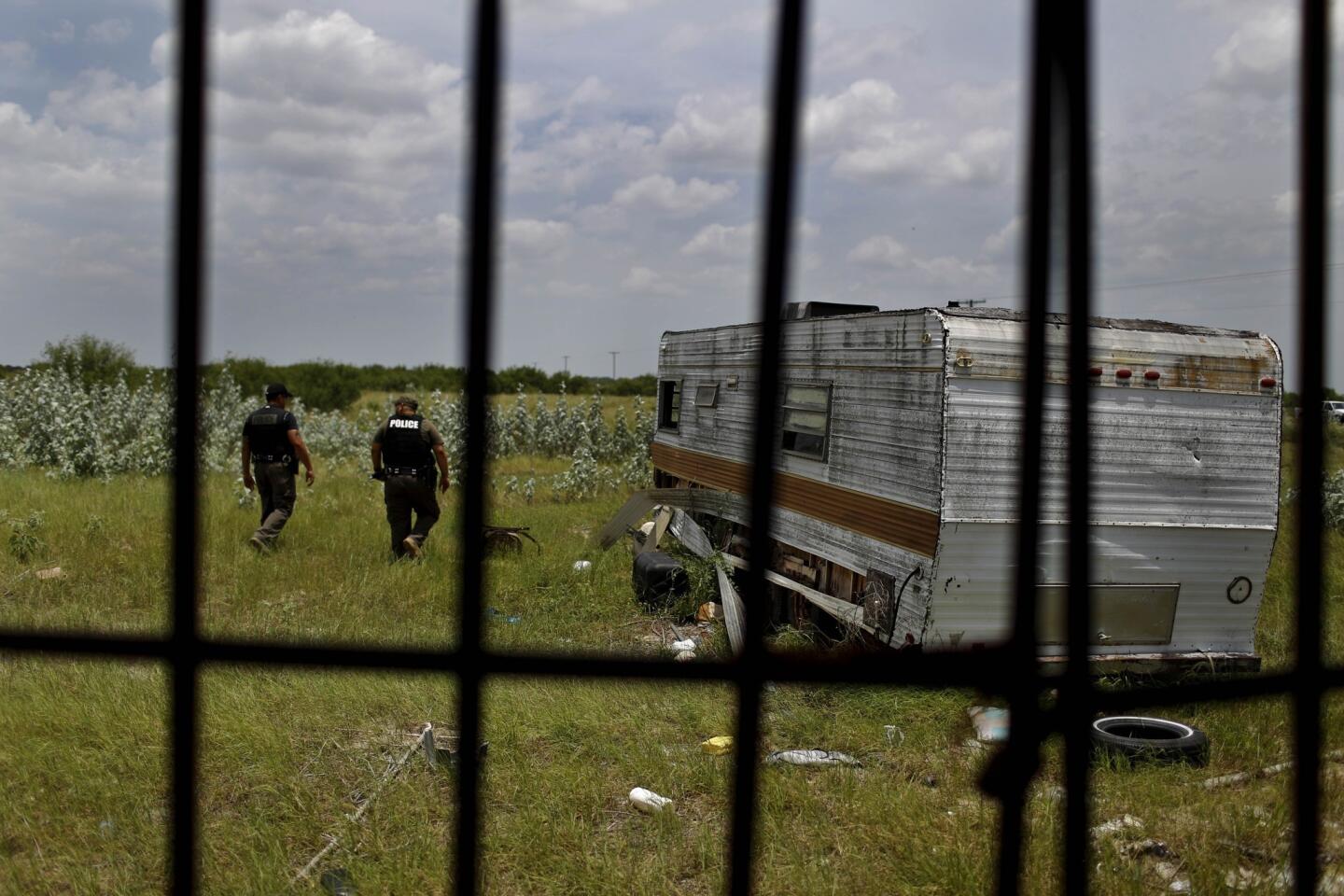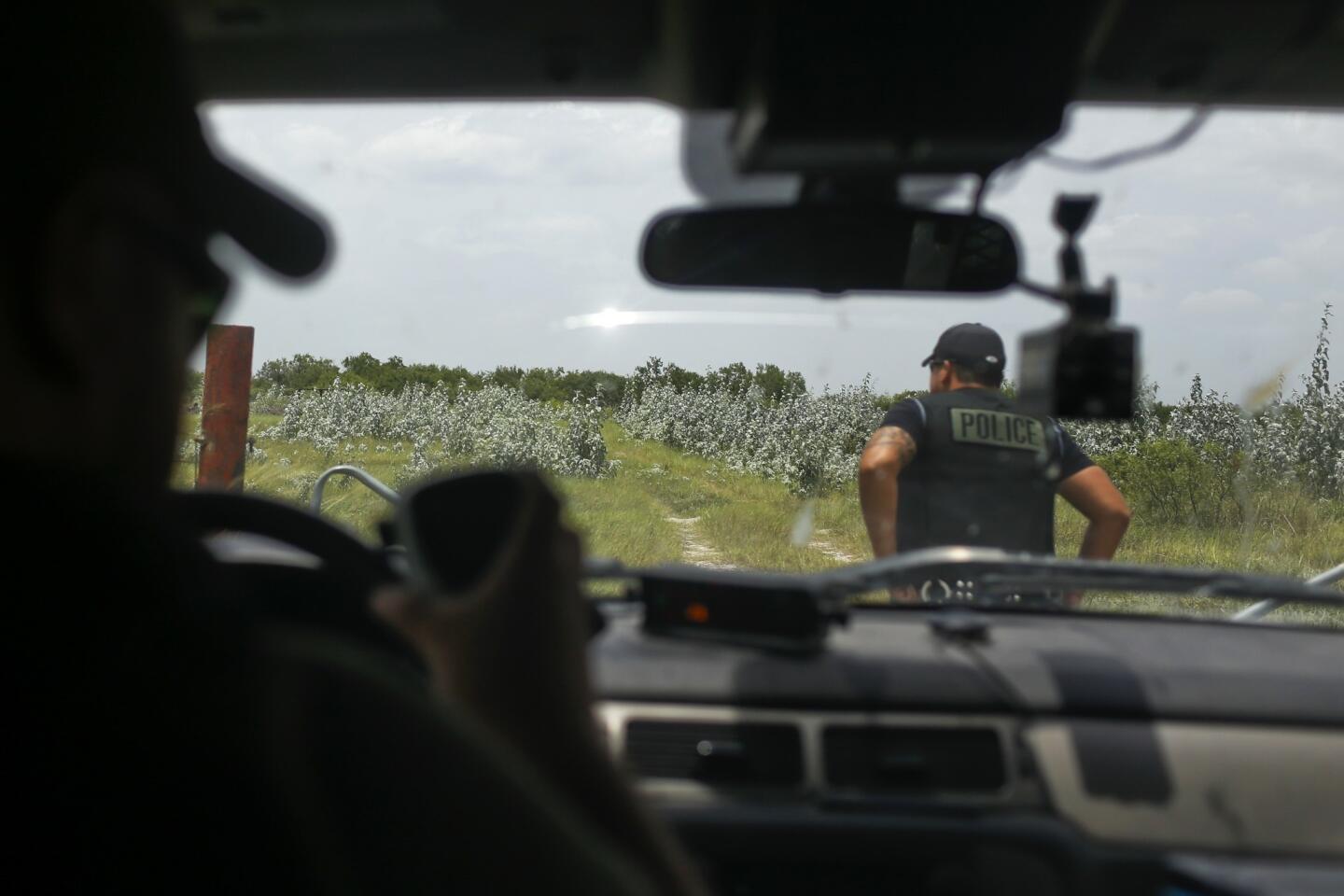Migrant crisis expands north from border, into arid Texas wilderness
- Share via
Reporting from Falfurrias, Texas — Daniel Zamarripa loaded his police dog into the back of his patrol car and set out to track his quarry — immigrants circumventing the local Border Patrol checkpoint.
Zamarripa, 27, is one of 15 reserve deputies brought in to assist the Brooks County Sheriff’s Office, whose four deputies have lately found themselves overwhelmed by 911 calls from migrants stranded on the vast ranches that stretch from here to the horizon in all directions.
Then there are the bodies of migrants who didn’t make it to retrieve and identify: 42 so far this year.
Most attention to the crisis on the Southwest border has focused in recent weeks on the Rio Grande Valley, where many of the 57,000 unaccompanied children and a large number of families have crossed from Mexico since October, twice last year’s total. Many surrender to immigration agents willingly at the Rio Grande, aware that they will be allowed to stay pending immigration court hearings.
But an unknown number end up here, 70 miles north of the border, in the meadows and scrubland that have become the region’s deadliest killing fields for migrants. Since 2009, authorities have recovered more than 400 immigrants’ bodies in the county, including that of a 16-year-old Central American boy discovered last month.
The land looks deceptively welcoming. Thick stands of scrub oak and mesquite give way to grasslands where cows graze. Everything is so green, it seems a pond or river must be around the next bend.
They are not.
As Zamarripa drove onto a ranch late last week, he cautioned that the landscape can be hypnotically similar. Getting lost is easy. The high that day was 100 degrees, with 67% humidity evident in sultry breezes. Zamarripa glanced back at Ivan, a big Belgian Malinois, who was panting in his carrier.
According to Chief Sheriff’s Deputy Urbino “Benny” Martinez, officers have been catching 30 to 40 immigrants in the county a week, about double the number six months ago.
“Up here, they’re trying to hide,” he said. “The only time they give themselves up is when they’re tired and they fear they’re dying.”
Law enforcement is under growing pressure to move quickly to save migrants and recover the dead. The challenge comes at a bad time of year, when brush is still abundant and high from recent rains, concealing both migrant routes and human remains.
“These are critical months,” Martinez said. “When the vegetation goes down, that’s when you start locating bodies.”
Martinez does not receive direct federal funding for border security because his county lies too far north. He has been trying to coordinate a group of volunteer searchers to help deputies.
For officers like Zamarripa and his partner, Domingo Aguirre, 31, there’s a sense of urgency, even on hot, slow days — a sense that they’re missing someone lost in the scrub.
Smugglers generally ferry immigrants in groups from the valley up to a road south of the Border Patrol checkpoint. The immigrants are expected to skirt the checkpoint and walk along back roads and through the brush 25 to 30 miles north to another road known as a pickup point.
Some are misled by the smugglers.
“We had one a few weeks ago, they told him when they dropped him off he only had to walk a few miles to reach his final destination: Houston,” Aguirre said.
Houston is 270 miles north.
“They see the lights and think it’s Houston,” Aguirre said. “When we tell them it’s Falfurrias, that they’re far away, they give up.”
The officers slowed near a work site where several men were installing a natural gas pipeline. Immigrants follow the pipeline north, they said.
Zamarripa turned onto a paved road.
“The pickup area,” he said. “This is a dangerous road. There should be no one traveling this except the ranchers.”
Today, no one was.
Zamarripa and Aguirre usually live and work as school police in the Rio Grande Valley. Zamarripa is the shorter of the two, with a goatee. Other than that, they are a clean-cut matched set in black, bulletproof vests, reflective shades, tactical pants and short sleeves that reveal tattooed biceps.
Zamarripa drove on, back toward the checkpoint, past a sign with an arrow saying, “Town.”
He stopped at an abandoned machine shop where five immigrants were recently caught. The back door gaped open. Inside, the deputies found signs of new arrivals: empty electrolyte water bottles, a crumpled pair of black denim shorts and a red Spider-Man backpack next to a torn mattress.
They checked an adjacent trailer: Again, no people. But even when immigrants can’t be seen, their presence is inescapable: Another mattress, more electrolyte bottles, a woman’s black elastic snap belt.
Zamarripa recalled asking a group of immigrants he apprehended why they came so far north.
“They could just stay in the valley. They could blend in,” he said.
The simple answer: Houston.
“All we hear about is Houston,” he said. “Houston’s the promised land to them.”
As the deputies finished their patrol that afternoon, a few miles across town, Eddie Canales was starting his.
Canales, a former carpenter’s union organizer in jeans and a polo shirt as gray as his short hair, was loading jugs of water into the back of his pickup outside his office at the South Texas Human Rights Center in Falfurrias.
He got permission from ranchers to install the “water stations” — barrels loaded with the jugs — in April. He has 35 in place, and plans to have 60 by summer’s end.
At first, he placed barrels on the more remote roads migrants frequent. In recent weeks, he grew concerned as more children headed north, and he set up barrels closer to the highway, where youths in distress might hear traffic and seek help.
When Canales started, he refilled the barrels every two weeks. Now he refills them weekly. On this day, he checked a barrel stationed beneath power lines that migrants often follow north. He had filled it with at least a dozen gallon jugs a week earlier.
“Empty. Completely empty.”
Canales replaced the jugs and drove on, a cross and religious medals jingling from his rearview mirror. He passed two ranches whose owners have not allowed him to add water barrels. Canales said he plans to call and try to persuade them.
As a human rights worker, Canales fields calls from families of missing migrants. He was swamped last month, after state officials began investigating mass graves discovered at a funeral home charged with handling some of the immigrants’ bodies found in the region.
A Guatemalan man called from Boston, desperate to find his young sister; he’d paid $9,500 to get her across. Canales thinks he may have found the body.
“It’s very difficult unless you encounter someone within one or two days,” he said.
In his office, Canales has a white binder full of photographs of bodies, often young men in jeans and T-shirts collapsed under trees, their faces bloated.
“Even though total immigration is down compared to the last decade, apprehensions are up and deaths are up,” he said.
He recently came upon two Salvadoran men wandering a ranch after apparently being dropped off there by a smuggler. Canales asked if they had jumped a fence since then. No, they said. That meant they had never left the ranch; they had been walking in circles.
Canales drove on to another barrel. He hadn’t seen any immigrants today, but he’d been doing this long enough to know that what counted was what he didn’t see. He gestured to low stands of trees as the brutal sun slowly sank.
“They’re in here,” he said. “People are in here.”
Twitter: @mollyhf
More to Read
Sign up for Essential California
The most important California stories and recommendations in your inbox every morning.
You may occasionally receive promotional content from the Los Angeles Times.

















